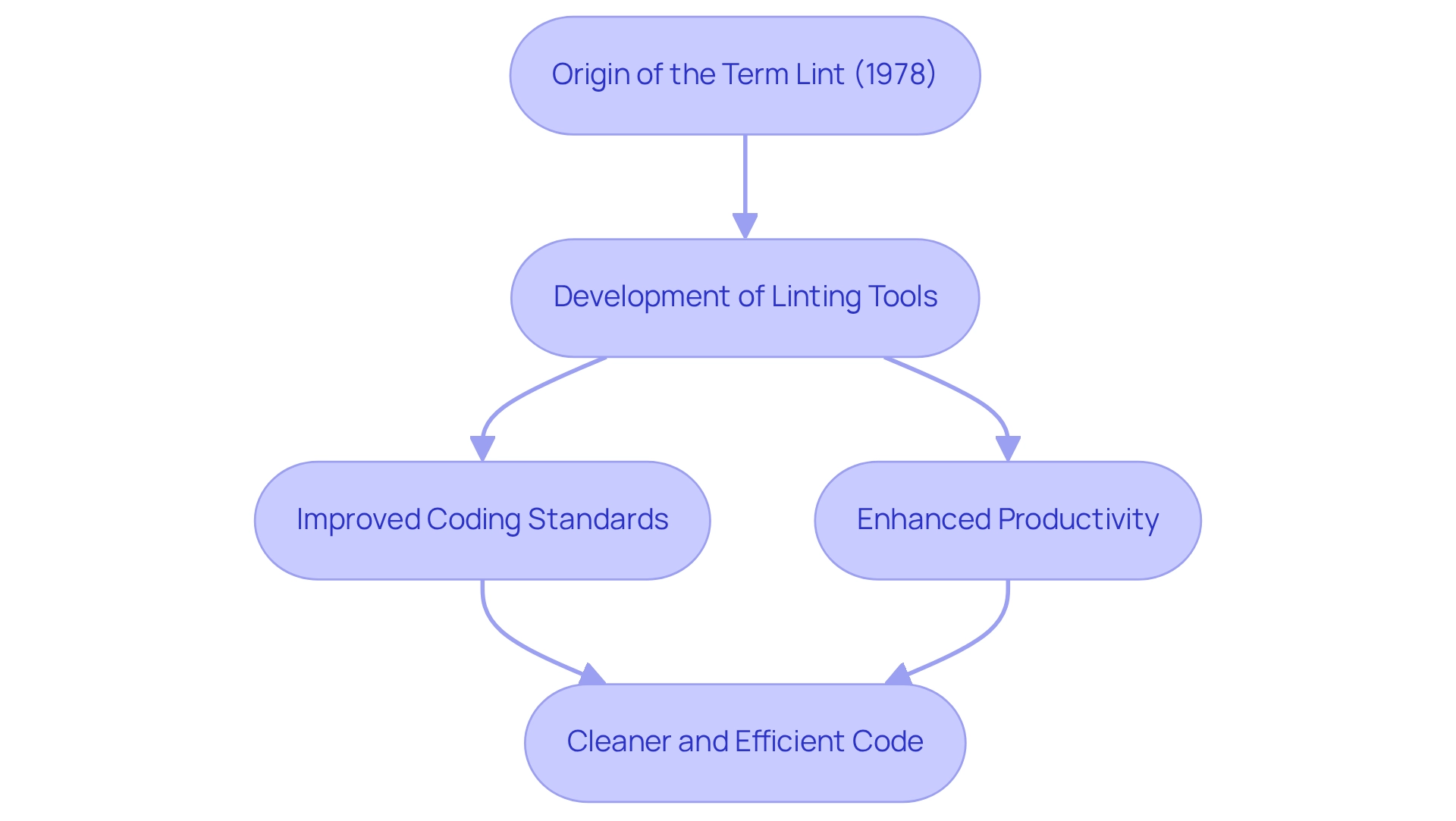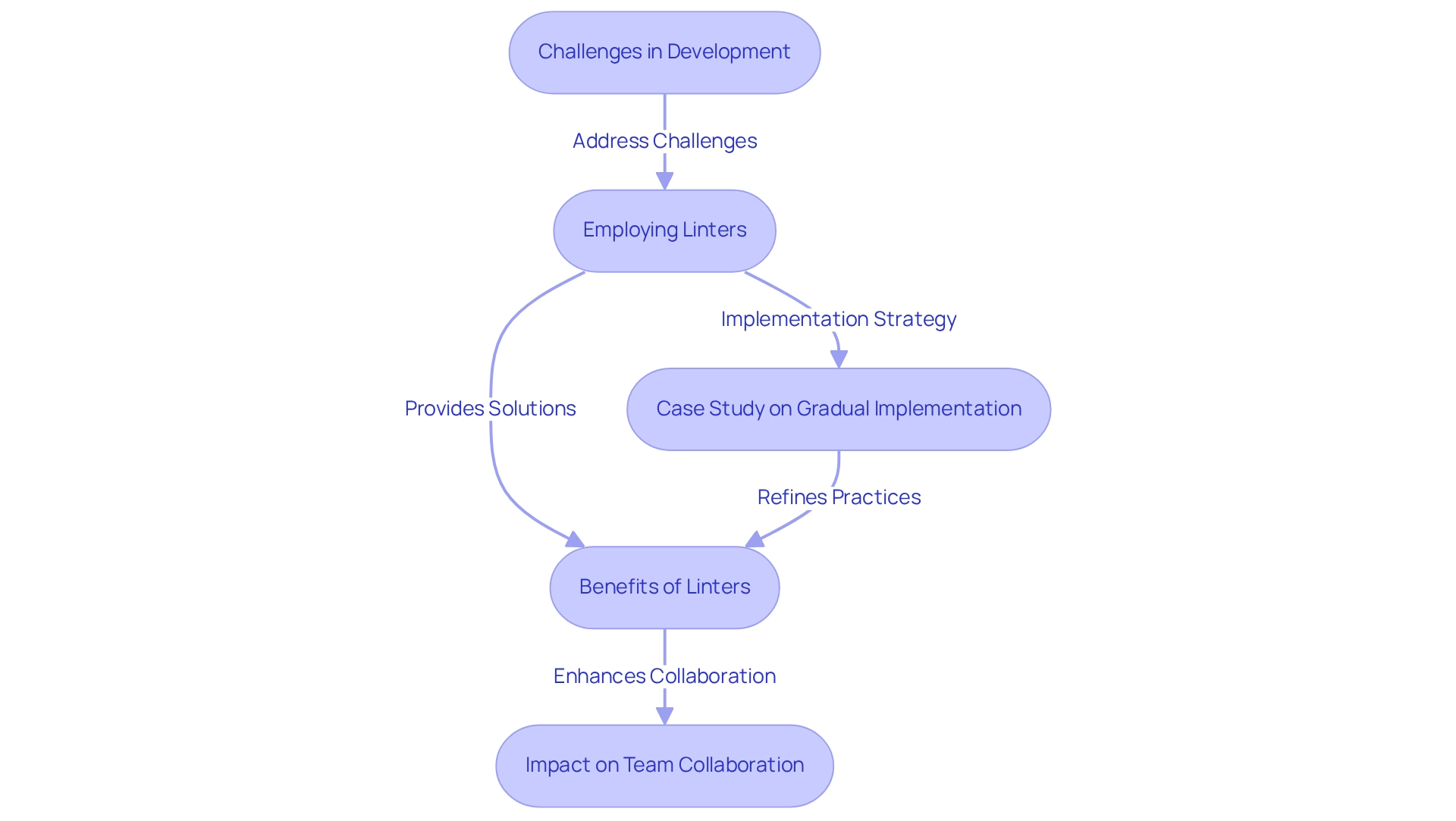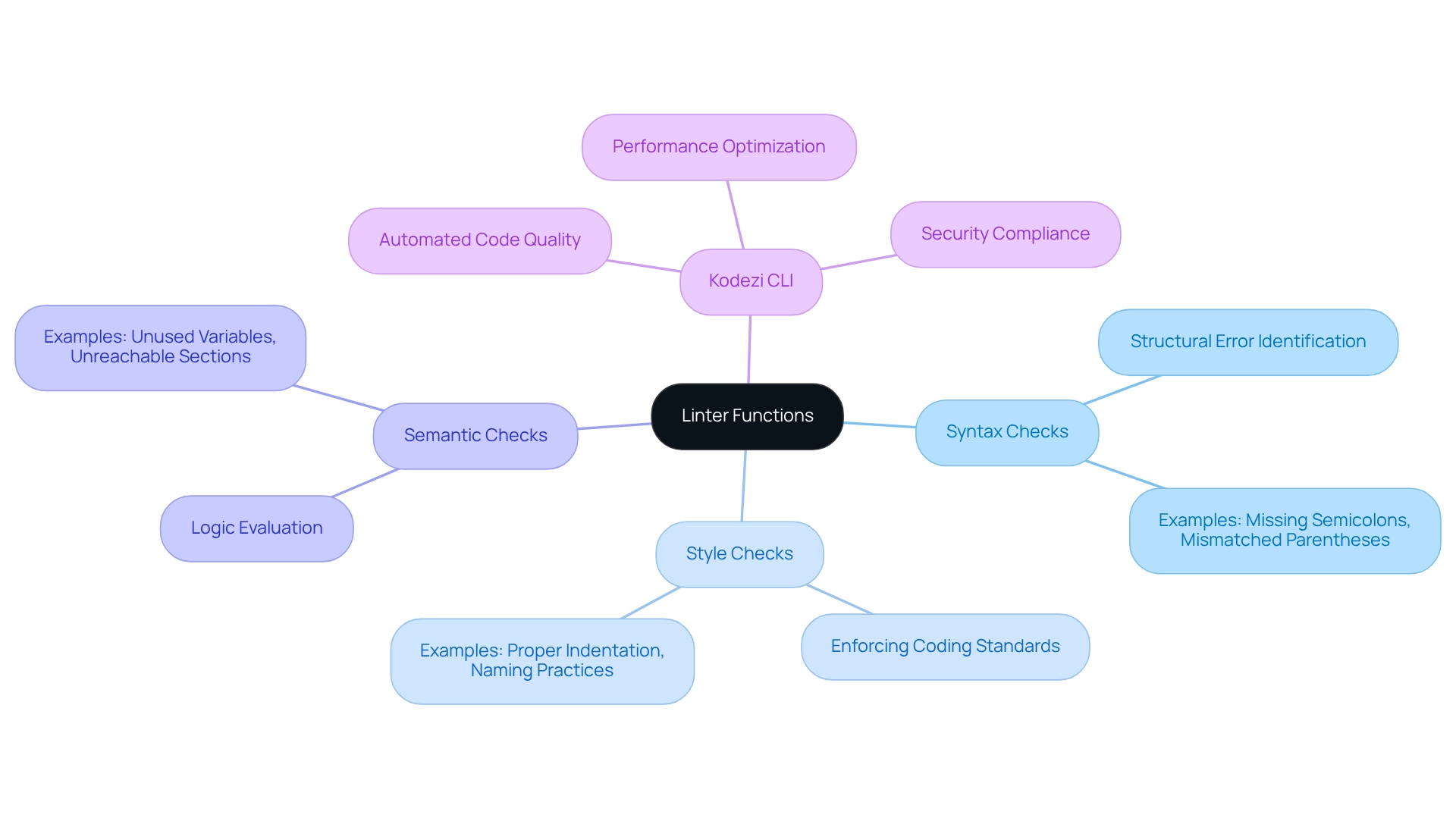Overview
Coding can be fraught with challenges, as developers often encounter potential errors, bugs, and stylistic discrepancies in their code. How can these issues be mitigated? Linters serve as essential static analysis tools that help identify these problems before execution. They perform critical functions, such as syntax, style, and semantic checks, promoting adherence to programming standards. Furthermore, by incorporating linters into your workflow, you can streamline the development process and enhance both code quality and maintainability.
Imagine the boost in productivity when you can catch errors early on. Linters not only identify issues but also guide developers towards best practices, ensuring cleaner and more efficient code. This leads to more robust software, ultimately benefiting the entire development team. In addition, using linters fosters a culture of quality and consistency, which is vital in collaborative environments.
Are you ready to improve your coding practices? Explore the tools available on Kodezi to experience the advantages of integrating linters into your development process. By doing so, you can enhance your coding efficiency and produce higher-quality software with ease.
Introduction
In the world of software development, developers often grapple with the challenges of producing clean, efficient, and reliable code. Have you ever found yourself tangled in the complexities of programming? This is where linters come into play, acting as essential allies in your quest for coding excellence. These powerful static code analysis tools meticulously examine your source code for potential errors, stylistic inconsistencies, and adherence to coding standards. By doing so, they significantly enhance both code quality and maintainability.
The concept of linting has evolved since its inception in the late 1970s, transforming into an indispensable component of modern development practices. By catching errors early and promoting best practices, linters streamline the coding process and foster a collaborative environment where creativity can thrive. Imagine being able to focus on complex challenges while ensuring the integrity of your codebase—this is the promise linters offer.
Furthermore, integrating linters into your development workflow reveals a world of efficiency gains. With real-world examples and statistics highlighting their impact, it becomes clear how these tools empower developers. They not only simplify coding but also elevate the overall quality of software projects. Are you ready to explore how Kodezi can enhance your coding experience and improve productivity? Discover the tools available on the platform and take your coding to the next level.
Define Linter: Understanding Its Role in Programming
Coding challenges are a common hurdle for developers, often leading to errors and inefficiencies. The meaning of linter is a static analysis tool that is designed to examine source material for possible errors, bugs, stylistic discrepancies, and adherence to programming standards. By analyzing scripts without executing them, these tools empower developers to identify problems early in the development process, significantly enhancing quality and maintainability. Kodezi CLI exemplifies how integration into various development environments can streamline coding practices across multiple programming languages.
Statistics indicate that a cyclomatic complexity exceeding 10 frequently points to defects in the program that require attention. Understanding the meaning of linter is crucial in managing this complexity, flagging potential issues before they escalate and ensuring high programming standards. Tools like Kodezi CLI autonomously enhance software projects, resolving issues prior to production. This allows developers to deploy updates without disrupting their systems. Kodezi CLI quickly identifies and rectifies codebase issues, offering detailed explanations and insights into the problems encountered and their resolutions. Case studies reveal that utilizing analysis tools, including style checkers, provides immediate feedback, enabling programmers to address issues as they arise. This proactive approach not only boosts code quality but also enhances job satisfaction, fostering a more creative and productive programming environment.
Real-world examples illustrate how developers leverage code analysis tools to catch errors early, which frees them to focus on more complex tasks like architectural decisions and intricate bug fixes. As Sara Verdi, a software engineer at Graphite, notes, "By identifying routine problems such as programming standard violations or basic logical mistakes, tools allow human reviewers to concentrate on more substantial issues like architectural choices or intricate bug resolutions." User testimonials underscore Kodezi's impact on debugging efficiency, with over 1,000,000 users praising its ability to enhance productivity and streamline the debugging process. Ultimately, the meaning of linter is essential in elevating programming standards, ensuring adherence to development guidelines while keeping the development process efficient.

Trace the Etymology: The Origin of 'Lint' in Programming
Coding challenges are a common hurdle for developers, often leading to inefficiencies and errors in their work. The term 'lint' in programming traces its roots back to a utility created by Stephen C. Johnson at Bell Labs in 1978. This groundbreaking tool was designed to examine C source text for potential mistakes and inefficiencies, representing a substantial improvement in software management. The name 'lint' itself serves as a metaphor, derived from the tiny fibers and fluff that accumulate on clothing, symbolizing the minor errors and issues that can clutter codebases.
As the programming landscape evolved, so did the concept of linting. Today, various tools serve similar functions across multiple programming languages, assisting developers in maintaining coding standards. Furthermore, these linting tools have become essential to contemporary development practices, improving overall programming quality. By addressing common pain points, they help developers enhance productivity and ensure cleaner, more efficient code.
Have you considered how linting might streamline your coding process? The benefits of using linting tools are substantial, as they not only help identify errors but also promote best practices in coding. By integrating these tools into your workflow, you can significantly improve your code quality and efficiency. Explore the various linting tools available and experience the difference they can make in your programming endeavors.

Explore the Importance: Benefits of Using Linters in Code Development
In the realm of software development, developers often face significant challenges, such as ensuring code quality and minimizing debugging time. Employing code analysis tools can address these issues effectively. Kodezi offers solutions that enhance productivity, such as automatic programming correction and bug analysis, which are essential for maintaining high programming standards, and the meaning of linter is significant as code analysis tools play a pivotal role in this process. By identifying errors before execution, they substantially reduce the likelihood of bugs infiltrating production environments. Furthermore, the meaning of linter is to enforce programming standards, promoting consistency across codebases—an essential component for effective team collaboration. For example, tools such as ESLint for JavaScript and Pylint for Python are instrumental in upholding these standards, ultimately enhancing the overall quality of software.
Consider a case study on the gradual introduction of stricter linting regulations. This approach demonstrates that starting with fundamental guidelines and progressively enforcing more rigorous ones allows teams to adjust smoothly. By refining rules based on actual project needs, this method mitigates the risk of overwhelming developers and fosters a culture of ongoing improvement. Such a culture not only enhances team cooperation but also aligns perfectly with Kodezi's mission to empower developers.
Furthermore, analysis tools provide invaluable feedback during code reviews, streamlining the evaluation process and encouraging better programming practices among team members. As part of the 'shift-left' movement in software development, which emphasizes early program assessment, the meaning of linter is crucial in refining the overall development process. This is particularly relevant to Kodezi's offerings, which support developers in maintaining high standards throughout their coding practices, ensuring that codebases are auto-healed before reaching production.
Are you ready to elevate your coding practices? Explore the comprehensive tools available on Kodezi's platform to experience the benefits firsthand.

Examine Linter Functions: Types of Checks and Code Standards
Developers often encounter significant challenges in maintaining code quality. Linters play a crucial role in this process by conducting a range of evaluations, which illustrate the meaning of linter through:
- Syntax checks
- Style checks
- Semantic checks
Syntax checks identify structural errors, such as missing semicolons or mismatched parentheses, while style checks enforce coding standards—ensuring readability and consistency through proper indentation and naming practices. Furthermore, semantic checks evaluate the logic of the program, flagging potential issues like unused variables or unreachable sections.
In addition to traditional linters, Kodezi CLI emerges as an autonomous solution tailored for B2B engineering teams. It automatically identifies and rectifies codebase issues before they reach production, significantly enhancing programming productivity. By optimizing performance, ensuring security compliance, and adhering to coding standards, Kodezi CLI addresses common coding challenges head-on.
But what are the tangible benefits of using Kodezi? By leveraging AI-driven automated builds and testing, Kodezi CLI maintains code quality, ultimately leading to more robust and maintainable software. This not only streamlines the development process but also empowers teams to focus on innovation rather than troubleshooting.
Explore the tools available on the Kodezi platform today and discover how they can transform your coding practices, ensuring you uphold high standards of programming excellence.

Conclusion
Coding challenges are an undeniable reality in the software development landscape. Developers often grapple with maintaining code quality and ensuring compliance with standards. This is where linters come into play, particularly tools like Kodezi, which provide static code analysis to help identify potential errors and stylistic inconsistencies before code execution. By addressing these issues proactively, Kodezi mitigates the risk of bugs reaching production, allowing developers to focus on complex challenges. This not only enhances job satisfaction but also boosts overall productivity.
The evolution of linting, from its inception in the late 1970s to its current state, underscores its significance in modern development practices. With tools like Kodezi, developers can efficiently manage code complexity and enforce best practices. This streamlining of the coding process cultivates a culture of continuous improvement within teams, fostering collaboration and innovation.
As the development community increasingly embraces linters, the benefits become more apparent. Enhanced readability, improved debugging efficiency, and a commitment to coding standards are just a few advantages of integrating linters into the development workflow. By prioritizing code quality and leveraging tools like Kodezi, developers can ensure their projects remain robust, maintainable, and ready for the challenges of tomorrow. So why not explore the tools available on Kodezi? Discover how they can transform your coding practices and lead to greater efficiency and satisfaction.
Frequently Asked Questions
What is a linter?
A linter is a static analysis tool designed to examine source code for possible errors, bugs, stylistic discrepancies, and adherence to programming standards without executing the code.
How does a linter benefit developers?
Linters empower developers to identify problems early in the development process, significantly enhancing code quality and maintainability by flagging potential issues before they escalate.
What is Kodezi CLI?
Kodezi CLI is a tool that integrates into various development environments to streamline coding practices across multiple programming languages, autonomously enhancing software projects and resolving issues prior to production.
What is cyclomatic complexity, and why is it important?
Cyclomatic complexity is a software metric that indicates the complexity of a program. A cyclomatic complexity exceeding 10 often points to defects that require attention, making it crucial for developers to manage this complexity.
How does Kodezi CLI improve debugging efficiency?
Kodezi CLI quickly identifies and rectifies codebase issues, providing detailed explanations and insights, which enhances debugging efficiency and allows developers to deploy updates without disrupting their systems.
What impact do code analysis tools have on programming tasks?
Code analysis tools help developers catch errors early, allowing them to focus on more complex tasks, such as architectural decisions and intricate bug fixes, rather than routine problems.
What feedback have users provided regarding Kodezi?
User testimonials indicate that over 1,000,000 users praise Kodezi for its ability to enhance productivity and streamline the debugging process, significantly improving job satisfaction and fostering a more creative programming environment.
Why is understanding the meaning of a linter essential?
Understanding the meaning of a linter is essential for elevating programming standards, ensuring adherence to development guidelines, and maintaining an efficient development process.




